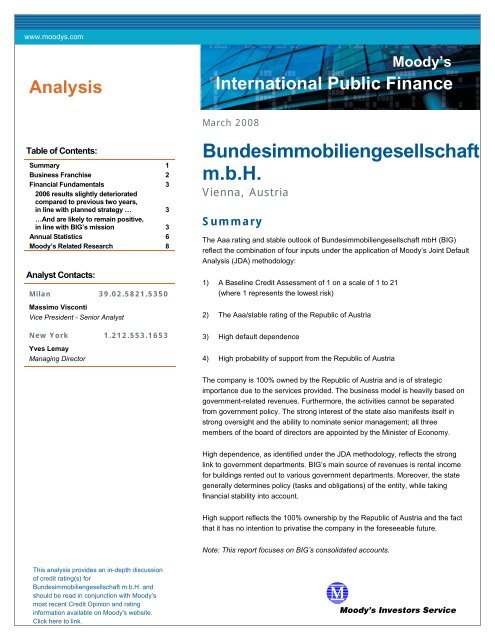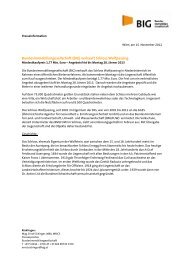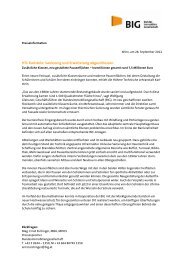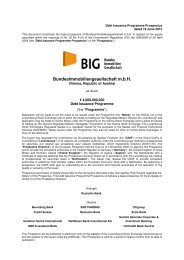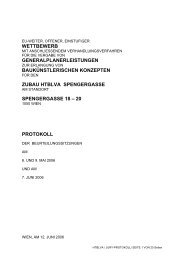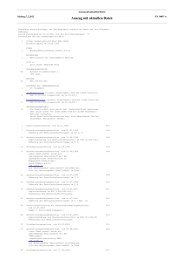Bundesimmobiliengesellschaft m.b.h. - BIG
Bundesimmobiliengesellschaft m.b.h. - BIG
Bundesimmobiliengesellschaft m.b.h. - BIG
Create successful ePaper yourself
Turn your PDF publications into a flip-book with our unique Google optimized e-Paper software.
www.moodys.com<br />
Analysis<br />
Table of Contents:<br />
Summary 1<br />
Business Franchise 2<br />
Financial Fundamentals 3<br />
2006 results slightly deteriorated<br />
compared to previous two years,<br />
in line with planned strategy … 3<br />
…And are likely to remain positive,<br />
in line with <strong>BIG</strong>’s mission 3<br />
Annual Statistics 6<br />
Moody’s Related Research 8<br />
Analyst Contacts:<br />
Milan 39.02.5821.5350<br />
15 Massimo Visconti<br />
Vice President - Senior Analyst<br />
New York 1.212.553.1653<br />
0 Yves Lemay<br />
Managing Director<br />
This analysis provides an in-depth discussion<br />
of credit rating(s) for<br />
<strong>Bundesimmobiliengesellschaft</strong> m.b.H. and<br />
should be read in conjunction with Moody’s<br />
most recent Credit Opinion and rating<br />
information available on Moody's website.<br />
Click here to link.<br />
Moody’s<br />
International Public Finance<br />
March 2008<br />
<strong>Bundesimmobiliengesellschaft</strong><br />
m.b.H.<br />
Vienna, Austria<br />
Summary<br />
The Aaa rating and stable outlook of <strong>Bundesimmobiliengesellschaft</strong> mbH (<strong>BIG</strong>)<br />
reflect the combination of four inputs under the application of Moody’s Joint Default<br />
Analysis (JDA) methodology:<br />
1) A Baseline Credit Assessment of 1 on a scale of 1 to 21<br />
(where 1 represents the lowest risk)<br />
2) The Aaa/stable rating of the Republic of Austria<br />
3) High default dependence<br />
4) High probability of support from the Republic of Austria<br />
The company is 100% owned by the Republic of Austria and is of strategic<br />
importance due to the services provided. The business model is heavily based on<br />
government-related revenues. Furthermore, the activities cannot be separated<br />
from government policy. The strong interest of the state also manifests itself in<br />
strong oversight and the ability to nominate senior management; all three<br />
members of the board of directors are appointed by the Minister of Economy.<br />
High dependence, as identified under the JDA methodology, reflects the strong<br />
link to government departments. <strong>BIG</strong>’s main source of revenues is rental income<br />
for buildings rented out to various government departments. Moreover, the state<br />
generally determines policy (tasks and obligations) of the entity, while taking<br />
financial stability into account.<br />
High support reflects the 100% ownership by the Republic of Austria and the fact<br />
that it has no intention to privatise the company in the foreseeable future.<br />
Note: This report focuses on <strong>BIG</strong>’s consolidated accounts.
Analysis Moody’s International Public Finance<br />
<strong>Bundesimmobiliengesellschaft</strong> m.b.H.<br />
Portfolio<br />
Management<br />
Business Franchise<br />
<strong>BIG</strong> was created by law in 1992 with the objective of centralising property management for Austria’s public<br />
sector, with a view to improving efficiency and, more specifically, the cost-efficiency of various government<br />
departments. The underlying premise was that obliging departments to pay and account for their usage of<br />
buildings would force them to rationalise their use of space and allow surplus stock to be put to alternative use<br />
or sold off.<br />
Following a revision of the act regulating <strong>BIG</strong>’s activities in 2000, the entity now owns the properties previously<br />
leased from the state. The purchase price was set at €2.4 billion, with the transfer being completed during<br />
2003. The purchase was financed with debt.<br />
Moody’s views €2.4 billion as a fair price for the transferred assets. According to an independent valuation of<br />
the properties by the Technische Universität Wien (Technical University of Vienna), the market value was €6.9<br />
billion. The lower transfer value takes into account the specialist nature of the properties – i.e. they possibly<br />
have a lower resale value – and future investment needs. Moreover, if <strong>BIG</strong> sells any of the transferred assets<br />
with a positive margin over the purchase price, it has to pay a share of the gain to the state, i.e. a formulaic<br />
calculation of the share, taking into account the gain on the disposal. The agreement with the state was<br />
revised as of 1 January 2005, allowing <strong>BIG</strong> to offset some costs prior to paying out around 80% of the gain.<br />
Figure 1: Organization Chart<br />
Consumer<br />
Management<br />
Press<br />
Revision<br />
Org & Quality<br />
<strong>BIG</strong><br />
<strong>Bundesimmobiliengesellschaft</strong> m.b.H.<br />
Management Board<br />
Object<br />
Management<br />
Planning and<br />
Construction<br />
5 Teams 18 Teams 4 Regional<br />
Teams<br />
<strong>BIG</strong> has undertaken several initiatives toward continued rationalisation of its business model and its internal<br />
procedures, seeking for ever-higher efficiency and effectiveness in all its activities. It is noteworthy that <strong>BIG</strong>’s<br />
adoption of IFRS for the first time in 2007 is expected to be smooth as the company has already taken all<br />
necessary steps to ensure successful transition.<br />
<strong>BIG</strong> has responsibility for managing the Austrian Republic’s real estate, with a portfolio largely dominated by<br />
schools and universities (71%) and other federal tenants such as prisons, police stations and court houses<br />
(27%) at year-end 2006. <strong>BIG</strong>’s activities involve renting out the buildings to the various government entities,<br />
2 March 2008 Analysis Moody’s International Public Finance - <strong>Bundesimmobiliengesellschaft</strong> m.b.H.<br />
Facility<br />
Services<br />
CAD and<br />
Space<br />
Management
Analysis Moody’s International Public Finance<br />
<strong>Bundesimmobiliengesellschaft</strong> m.b.H.<br />
carrying out renovations and new investments, and handling sales of redundant buildings and land. <strong>BIG</strong>’s<br />
holdings include a small residential property portfolio, mainly comprising the current and former homes of civil<br />
servants and other public sector employees (2%). <strong>BIG</strong> also offers facilities management services if required by<br />
the tenants.<br />
<strong>BIG</strong> consists of a holding company, <strong>Bundesimmobiliengesellschaft</strong> mbH (<strong>BIG</strong>), and – following the successful<br />
merger by incorporation of its subsidiary <strong>BIG</strong> Services, or IMB (Immobilienmanagementgesellschaft des<br />
Bundes) in 2006 – two main subsidiaries, <strong>BIG</strong> Finanzdienstleistungen GMBH and <strong>BIG</strong> Entwicklungs- Und<br />
Verwertungs GMBH, which are both 100% owned by <strong>BIG</strong> and consolidated into its accounts. The group also<br />
consolidates an array of companies related to particular buildings and projects.<br />
More than €XX billion will be spent in Austrian real estate between 2008 and 2010; Key priorities going forward<br />
continue to be the optimisation of key business, i.e. leasing of real estate to the federal Republic’s<br />
administration and project development with strategic partners.<br />
Financial Fundamentals<br />
2006 results slightly deteriorated compared to previous two<br />
years, in line with planned strategy …<br />
The 2006 operating results were slightly down compared to 2005 (at €222.7 million vs. €233.4 million). Pre-tax<br />
profit was €86.9 million, down 15.7% compared to 2005 and 4.7% vs. 2004, largely due to other operating<br />
expenditures (€65 million vs €24 million the year before). Slightly lower revenues from financial activities,<br />
namely interest proceeds and income from investments and from other securities, loans and advances, as well<br />
as minor taxes paid, further contributed to generating a financial surplus of €50.3 million in 2006, down by<br />
11.7% compared to 2005 but still higher than 2004.<br />
…And are likely to remain positive, in line with <strong>BIG</strong>’s mission<br />
Total consolidated pre-tax results for 2007 are reported to be close to 2005 levels, mainly thanks to higher<br />
turnover and the lower level of one-off items. Expectations going forward are in line with business plan of the<br />
past 10 years, with pre-tax profits expected to remain positive, albeit lower on average than in 2006, given the<br />
expected higher growth of depreciation and financial expenditure; this is in line with <strong>BIG</strong>’s mission as the entity<br />
is not meant to be a profit maximiser. On the one hand, some savings are expected from lower maintenance<br />
and service costs. On the other hand, growth in rental income is expected to be modest at 2.65% a year over<br />
the period 2008-2013, mainly thanks to the proposed second rental adjustment in 2011, under the five-year<br />
rent-adjustment mechanism. Other income – including that arising from service contracts and the disposal of<br />
properties – is expected to continue to represent around 13% of total operating revenues in the considered<br />
period.<br />
RENTAL INCOME AND OCCUPANCY<br />
Rental income is the mainstay of <strong>BIG</strong>’s income, representing nearly 83% of total operating revenues<br />
(excluding capital gains) in 2006. Of this, 98% comprises rents received from the state – i.e. from various<br />
ministries that use the buildings, although the universities now pay <strong>BIG</strong> directly from their governmentallocated<br />
annual operating budgets. As such, the universities have become the direct payers although the<br />
funds still stem from the Ministry of Education. Including such indirect payments, the Ministry for Education<br />
accounts for the majority (71%) of <strong>BIG</strong>’s rental income in the form of schools and universities, followed by<br />
other federal tenants (27%) and other tenants (2%). Rents are paid monthly or quarterly for all properties,<br />
whereas residential tenants pay rent on a monthly basis.<br />
In 2006, <strong>BIG</strong> sold properties worth nearly €47 million, of which €27 million was paid to the Federal Republic as<br />
required by the agreement signed with the state.<br />
There are options for giving notice under the rental agreements; the notice period is one year for tenants,<br />
covering 70% of the total revenue. However, the tenants are deemed to be relatively stable, since the<br />
3 March 2008 Analysis Moody’s International Public Finance - <strong>Bundesimmobiliengesellschaft</strong> m.b.H.
Analysis Moody’s International Public Finance<br />
<strong>Bundesimmobiliengesellschaft</strong> m.b.H.<br />
ministries need the properties as a base from which to provide services such as education. The notice periods<br />
for new projects or major renovations benefit from a clause that forbids the tenant from giving notice during the<br />
debt amortisation period (usually 20-25 years).<br />
RENTAL LEVELS TAKE INTO ACCOUNT A REASONABLE MARGIN AND<br />
THE NEED FOR INVESTMENT<br />
Rents have been fixed on a “market” basis, while taking into account the relatively specialised nature of the<br />
properties, and – as of 2003 – indexed to a designated consumer price index with a one-year time lag<br />
(currently CPI 1996). Adjustments are only permitted if they are 5% above this index, and the adjustment will<br />
then be in full. As such, the potential for rental increases is not considered to be particularly flexible. The first<br />
rental adjustment under this ruling was implemented in 2006, driving a corresponding increase in rental<br />
revenue following the small declines in 2004 which were a result of the gradual sell-off of non-core rental<br />
properties. The next adjustments, due to take place in 2011 and 2016, are expected to be slightly higher than<br />
initial value of €22 million previously forecast.<br />
COST KEPT UNDER CONTROL<br />
<strong>BIG</strong>’s management has successfully kept operating costs at an acceptable level through a focus on cost<br />
efficiency, with expenses related to materials, building and services declining by close to 9% since 2003.<br />
Overall we expect this prudent cost management to continue, with some one-off exceptions such as personnel<br />
items expected to grow by 13% in 2008 before growing in line with inflation in subsequent years. The<br />
headcount of 807 in 2007 is expected to remain stable in the next three-year period.<br />
The other main cost item is interest expense, which is less flexible as it relates to the relatively “inflexible” debt<br />
stock accumulated to fund previous asset purchases and future investment needs. Financial expenses<br />
(including interest, expenses from financial assets and expenses from associated entities) were down 2.7% in<br />
2006 compared with 2005, but are reported to have risen to 14.2% in 2007 following company’s recent<br />
investment activity. Expectations going forward are for a slighter increase on a yearly basis till 2013.<br />
Most of <strong>BIG</strong>’s investments are calculated for a period of 25 years, with a strong focus on sustainability, which<br />
translates into a strong focus on keeping maintenance costs at low and stable levels for the considered period<br />
(around €118 million per year). This brings predictability to the financial plan in the long term.<br />
<strong>BIG</strong> invested around €132 million on maintenance in 2006, the majority of which was spent on schools and<br />
universities (66%). <strong>BIG</strong> has also invested nearly €239.4 million in development projects and construction. At<br />
present, over 56 construction projects are being undertaken, amongst which are two office/residential<br />
developments in Vienna, namely the Karree St Marx and the Eurogate development. Going forward, <strong>BIG</strong><br />
expects annual construction investments (both construction projects and works) of €300-350 million in the<br />
medium term.<br />
MODERATE PACE OF DEBT GROWTH EXPECTED<br />
<strong>BIG</strong>’s stock of debt has grown rapidly since 2000 due to its purchase of properties from the central<br />
government; financial debt totalled €3.3 billion at the end of 2007, slightly lower than in 2006. Net debt in 2007<br />
(new issuances minus maturities) was negative in 2007.<br />
Based on its long-term budgets, <strong>BIG</strong>’s debt is not expected to grow considerably as the bulk of the assets from<br />
the state have now been purchased, although some minor purchases and some project investments are<br />
planned during the forecast period to 2010. Debt is expected to grow at a moderate pace of 1.9% a year,<br />
reaching €3.5 billion by year-end 2010.<br />
The maturity profile shows two peaks, in 2007 and in 2013, but is otherwise reasonably stable. Maturing<br />
issues tend to be refinanced and are generally well absorbed in the market as a consequence of the closeness<br />
of the issuer to the state. Interest rates and currency exposures are limited through the use of financial<br />
derivatives with high-quality counterparties (with ratings ranging from Aaa to A2). By the end of 2007, 79% of<br />
the overall exposure was at fixed rates with almost all debt euro-denominated.<br />
4 March 2008 Analysis Moody’s International Public Finance - <strong>Bundesimmobiliengesellschaft</strong> m.b.H.
Analysis Moody’s International Public Finance<br />
<strong>Bundesimmobiliengesellschaft</strong> m.b.H.<br />
OVERALL ADEQUATE LIQUIDITY PROFILE<br />
<strong>BIG</strong>’s cash flows are predictable, with 98% of the rental income (the mainstay of <strong>BIG</strong>’s income) coming from<br />
the state and being paid quarterly. Cash outflows, mostly project financing and debt servicing, are also<br />
predictable. Mismatches are funded via <strong>BIG</strong>’s €1 billion Euro Commercial Paper Programme (rated P-1). The<br />
average amount outstanding in 2007 was around €15.6 million vs. €66 million the year before. Additionally,<br />
<strong>BIG</strong> can still use short-term drawing rights with banks. No back-up facilities are in place, although the<br />
predictable nature of <strong>BIG</strong>’s cash flows and its closeness to the Austrian government are mitigating factors.<br />
HIGH DEPENDENCE<br />
The high dependence between <strong>BIG</strong> and the Federal Republic of Austria is due to the almost total reliance of<br />
its revenue structure on rental income from Austrian public institutions.<br />
HIGH PROBABILITY OF SUPPORT FROM THE FEDERAL REPUBLIC OF<br />
AUSTRIA<br />
The 100% ownership of <strong>BIG</strong> by the Republic of Austria provides comfort that the owner will:<br />
Support the entity in the event of a problem arising.<br />
Remain the main tenant of <strong>BIG</strong>, and hence provide revenue/margin stability.<br />
Determine policy (tasks and obligations) of the entity going forward, while taking financial stability into<br />
account.<br />
Supervise and control the activities of <strong>BIG</strong>.<br />
The state’s ownership could only be reduced below 100% through a change in the law pertaining to<br />
<strong>Bundesimmobiliengesellschaft</strong>. Although this is not impossible, to date the government has not signalled any<br />
intention to effect such a change, as <strong>BIG</strong> is regarded as a vital instrument in the management of the state’s<br />
properties. <strong>BIG</strong>’s accounts are audited by the Federal Audit Office.<br />
Furthermore, there are no plans to extend the entity’s activities to the private sector to a material degree.<br />
Although the law permits <strong>BIG</strong> to carry out commercial property marketing and development, such activities are<br />
supposed to be of a subsidiary nature and there are currently no plans to expand commercial activities beyond<br />
asset sales of surplus or unused properties and land. In fact, <strong>BIG</strong>’s new management reiterated in 2005 that<br />
activities will remain focused on the state, either in terms of new projects or further state asset purchases.<br />
Only a small amount will be the development of projects for third parties. In this regard, <strong>BIG</strong> envisages more<br />
projects that link state activity/policy with the private sector, like the ICT technology park in Tyrol, where the<br />
university will share a building with private enterprises.<br />
5 March 2008 Analysis Moody’s International Public Finance - <strong>Bundesimmobiliengesellschaft</strong> m.b.H.
Analysis Moody’s International Public Finance<br />
<strong>Bundesimmobiliengesellschaft</strong> m.b.H.<br />
Annual Statistics<br />
<strong>Bundesimmobiliengesellschaft</strong> m.b.H.<br />
Year 2001 2002 2003 2004 2005 2006<br />
Total Debt 2,418,149 3,237,960 3,679,596 3,652,976 3,559,434 3,530,926<br />
Debt due within one year 404,602 481,683 405,855 566,003 301,112 668,252<br />
Debt due after one year 2,013,547 2,756,277 3,273,741 3,086,973 3,258,321 2,862,673<br />
Profit and Loss<br />
Turnover 674,468 691,573 676,825 687,807 692,719 715,306<br />
Asset Sales 0 0 0 0 0 0<br />
Liquidation of Reserves 0 0 0 0 0 0<br />
Other 7,881 6,088 50,656 22,502 34,517 28,380<br />
Operating Revenues (EUR 000's) 682,349 697,661 727,481 710,309 727,236 743,685<br />
Materials, Building and Services 211,698 281,442 286,766 259,684 242,553 246,173<br />
Personnel 12,294 13,366 16,241 20,099 21,152 22,863<br />
Depreciation 118,871 150,100 164,715 178,086 205,077 186,437<br />
Other 80,311 17,888 20,551 20,265 25,045 65,500<br />
Operating Costs 423,174 462,797 488,273 478,134 493,827 520,973<br />
Operating Profit 259,175 234,865 239,208 232,175 233,409 222,712<br />
Securities Income 354 366 44 50 46 30<br />
Interest Receiveable 2,605 5,654 11,553 2,979 5,895 4,531<br />
Other Income 0 0 0 0 9,412 3,720<br />
Interest Expenses 119,955 135,510 146,692 144,189 144,901 143,067<br />
Other Expenses 0 0 0 0 3,229 1,014<br />
Depreciation 1 1 0 0 0 0<br />
Extraordinary Charges 11,142 0 0 0 0 0<br />
Extraordinary Income 0 1,116 0 0 0 0<br />
Pre-tax Profits 131,035 106,491 104,113 91,016 100,633 86,913<br />
Income Tax 47,833 45,970 45,514 44,703 43,627 36,565<br />
Profit for the year (Before<br />
Allocations To and From<br />
Reserves)<br />
6 March 2008 Analysis Moody’s International Public Finance - <strong>Bundesimmobiliengesellschaft</strong> m.b.H.<br />
83,202 60,521 58,599 46,313 57,006 50,348
Analysis Moody’s International Public Finance<br />
<strong>Bundesimmobiliengesellschaft</strong> m.b.H.<br />
<strong>Bundesimmobiliengesellschaft</strong> m.b.H.<br />
Year 2001 2002 2003 2004 2005 2006<br />
Balance Sheet<br />
Intangible Fixed Assets 312,563 248,284 17,715 16,751 9,257 8,089<br />
Tangible Fixed Assets 2,500,303 3,360,484 3,996,698 4,001,829 4,022,956 4,087,496<br />
Financial Assets 4,727 5,723 11,527 24,082 29,851 14,755<br />
Fixed Assets 2,817,593 3,614,492 4,025,940 4,042,661 4,062,064 4,110,341<br />
Stock 47,491 14,643 11,629 5,932 4,577 13,965<br />
Debtors 76,118 95,959 95,309 92,455 78,841 102,539<br />
Securities 0 0 0 0 0 0<br />
Cash 40 3,675 18 79 28,578 3,871<br />
Accruals and Deferrals 4,221 5,713 12,411 10,250 9,137 7,882<br />
Current Assets 127,870 119,990 119,367 108,716 121,133 128,257<br />
Total Assets 2,945,462 3,734,482 4,145,307 4,151,377 4,183,197 4,238,598<br />
Short-Term Debt 404,602 481,683 405,855 566,003 301,112 668,252<br />
Equity 355,798 323,161 322,017 395,418 447,476 483,930<br />
Untaxed Reserves 73,177 66,334 63,747 9,126 9,065 8,960<br />
Provisions 67,842 73,582 47,781 59,910 119,653 156,581<br />
Creditors 2,013,547 2,756,277 3,273,740 3,086,973 3,258,321 2,862,673<br />
Accruals and Deferrals 21,011 23,103 19,250 16,185 16,676 15,777<br />
Other 9,485 10,342 12,916 17,761 30,893 42,424<br />
Total Liabilities 2,540,860 3,734,482 4,145,307 4,151,377 4,183,197 4,238,598<br />
Ratios and Analysis<br />
Operating Margin (op. Surplus /<br />
turnover) (%)<br />
Interest Cover (Operating Surplus<br />
/ Interest Payable) (x)<br />
Operating Surplus / Total Debt<br />
(%)<br />
7 March 2008 Analysis Moody’s International Public Finance - <strong>Bundesimmobiliengesellschaft</strong> m.b.H.<br />
38.43% 33.96% 35.34% 33.76% 33.69% 31.14%<br />
2.16 1.73 1.63 1.61 1.61 1.56<br />
10.72% 7.25% 6.50% 6.36% 6.56% 6.31%<br />
Total Assets / LT Debt (x) 1.22 1.15 1.13 1.14 1.18 1.20<br />
Gearing (Debt / Equity) (x) 6.80 10.02 11.43 9.24 7.95 7.30<br />
EBITDA 381,004 390,986 415,520 413,291 453,839 417,431<br />
EBITDA / Turnover (%) 56.49% 56.54% 61.39% 60.09% 65.52% 58.36%<br />
EBITDA/Interest Expenses (x) 3.18 2.89 2.83 2.87 3.13 2.92
Analysis Moody’s International Public Finance<br />
<strong>Bundesimmobiliengesellschaft</strong> m.b.H.<br />
Moody’s Related Research<br />
Analysis:<br />
Austria, July 2007 (104122)<br />
Banking Statistical Supplement:<br />
Austria, November 2007 (106088)<br />
Rating Methodologies:<br />
The Application of Joint Default Analysis to Government Related Issuers, April 2005 (92432)<br />
The Application of Joint Default Analysis to Government Related Issuers, April 2005 - German version<br />
(92806)<br />
Special Comment:<br />
The Incorporation of Joint-Default Analysis into Moody's Corporate, Financial and Government Rating<br />
Methodologies, February 2005 (91617)<br />
To access any of these reports, click on the entry above. Note that these references are current as of the date of publication<br />
of this report and that more recent reports may be available. All research may not be available to all clients.<br />
8 March 2008 Analysis Moody’s International Public Finance - <strong>Bundesimmobiliengesellschaft</strong> m.b.H.
Analysis Moody’s International Public Finance<br />
<strong>Bundesimmobiliengesellschaft</strong> m.b.H.<br />
Report Number: 107845<br />
Author Production Specialist<br />
Massimo Visconti<br />
Yelena Ponirovskaya<br />
© Copyright 2007, Moody’s Investors Service, Inc. and/or its licensors and affiliates including Moody’s Assurance Company, Inc. (together, “MOODY’S”). All rights<br />
reserved. ALL INFORMATION CONTAINED HEREIN IS PROTECTED BY COPYRIGHT LAW AND NONE OF SUCH INFORMATION MAY BE COPIED OR<br />
OTHERWISE REPRODUCED, REPACKAGED, FURTHER TRANSMITTED, TRANSFERRED, DISSEMINATED, REDISTRIBUTED OR RESOLD, OR STORED<br />
FOR SUBSEQUENT USE FOR ANY SUCH PURPOSE, IN WHOLE OR IN PART, IN ANY FORM OR MANNER OR BY ANY MEANS WHATSOEVER, BY ANY<br />
PERSON WITHOUT MOODY’S PRIOR WRITTEN CONSENT. All information contained herein is obtained by MOODY’S from sources believed by it to be accurate<br />
and reliable. Because of the possibility of human or mechanical error as well as other factors, however, such information is provided “as is” without warranty of any<br />
kind and MOODY’S, in particular, makes no representation or warranty, express or implied, as to the accuracy, timeliness, completeness, merchantability or fitness<br />
for any particular purpose of any such information. Under no circumstances shall MOODY’S have any liability to any person or entity for (a) any loss or damage in<br />
whole or in part caused by, resulting from, or relating to, any error (negligent or otherwise) or other circumstance or contingency within or outside the control of<br />
MOODY’S or any of its directors, officers, employees or agents in connection with the procurement, collection, compilation, analysis, interpretation, communication,<br />
publication or delivery of any such information, or (b) any direct, indirect, special, consequential, compensatory or incidental damages whatsoever (including without<br />
limitation, lost profits), even if MOODY’S is advised in advance of the possibility of such damages, resulting from the use of or inability to use, any such information.<br />
The credit ratings and financial reporting analysis observations, if any, constituting part of the information contained herein are, and must be construed solely as,<br />
statements of opinion and not statements of fact or recommendations to purchase, sell or hold any securities. NO WARRANTY, EXPRESS OR IMPLIED, AS TO<br />
THE ACCURACY, TIMELINESS, COMPLETENESS, MERCHANTABILITY OR FITNESS FOR ANY PARTICULAR PURPOSE OF ANY SUCH RATING OR<br />
OTHER OPINION OR INFORMATION IS GIVEN OR MADE BY MOODY’S IN ANY FORM OR MANNER WHATSOEVER. Each rating or other opinion must be<br />
weighed solely as one factor in any investment decision made by or on behalf of any user of the information contained herein, and each such user must accordingly<br />
make its own study and evaluation of each security and of each issuer and guarantor of, and each provider of credit support for, each security that it may consider<br />
purchasing, holding or selling.<br />
MOODY’S hereby discloses that most issuers of debt securities (including corporate and municipal bonds, debentures, notes and commercial paper) and<br />
preferred stock rated by MOODY’S have, prior to assignment of any rating, agreed to pay to MOODY’S for appraisal and rating services rendered by it fees ranging<br />
from $1,500 to approximately $2,400,000. Moody’s Corporation (MCO) and its wholly-owned credit rating agency subsidiary, Moody’s Investors Service (MIS), also<br />
maintain policies and procedures to address the independence of MIS’s ratings and rating processes. Information regarding certain affiliations that may exist<br />
between directors of MCO and rated entities, and between entities who hold ratings from MIS and have also publicly reported to the SEC an ownership interest in<br />
MCO of more than 5%, is posted annually on Moody’s website at www.moodys.com under the heading “Shareholder Relations — Corporate Governance — Director<br />
and Shareholder Affiliation Policy.”<br />
9 March 2008 Analysis Moody’s International Public Finance - <strong>Bundesimmobiliengesellschaft</strong> m.b.H.


